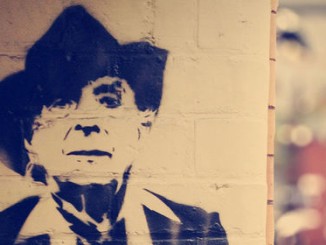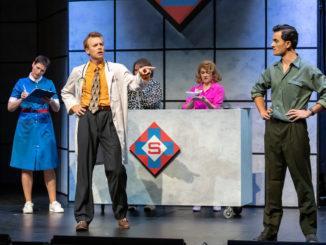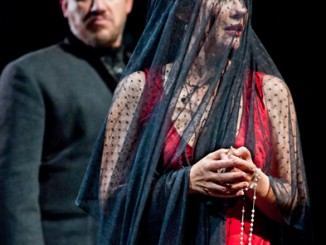
[Running on Empty]
Everyone in When Sun and Moon Collide are running from something, haunted by the spectres of their pasts. Briar Grace-Smith’s contemporary classic takes these figurative and metaphorical ghosts and brings them to the fore, tying them into a tangled mess of poetry made flesh. It’s a shame then that the aspirations and images evoked in the text aren’t always brought to life by Auckland Theatre Company’s revival.
It’s not hard to see the problems the text poses: putting a plot-driven narrative with clear dramatic reveals against a heavily symbolic backdrop. Set in and around a small-town tea room, the denizens and frequent inhabitants of this place are all haunted by a recent crime, the disappearance of a young Danish couple. Tensions simmer when the young owner of the tea room, Isaac (Jack Buchanan), is visited by Declan (Joe Dekkers-Reihana), an old friend who has just gotten out of jail. Then there’s also policewoman Travis (Kura Forrester) and Francie (Emily Campbell), who both seem fixated on Declan for different reasons.
So far so good, but the plot quickly and unbelievably escalates with coincidences and crimes stacking up to unbelievable heights, and delivering a conveniently optimistic ending. The most interesting stuff is in the play’s sharp edges, poking and stabbing dangerously in the peripheries. But this production often asks us to treat them at face value, relying on the overhanging mystery to add depth and dimension to the characters. It’s frustrating because the play is fertile ground for a study in dualities: Declan’s other persona of Jason; the dichotomy between nice guy and bad boy; Travis the police officer versus Mereana-Jean the woman and sister; and even Maori versus Pakeha. The premise is utterly Lynchian, evoking the seedy underbellies that lie beneath the suburban worlds of Twin Peaks and Blue Velvet, or to suggest a more local example, Top of the Lake. But these, and the many other ideas, are never clearly delineated, so we’re just left with plot.
Director Rawiri Paratene occasionally stumbles across the tiny, beautiful Chekhovian moments the play suggests. Those private moments in space and time where the characters simply exist, rather than being forced to move around like pawns on a chessboard. Because the play isn’t at its most exciting when the threat of violence is on the horizon, but when the audience becomes privy to something intimate and sacred. When we’re allowed to settle into the humdrum reality of Isaac’s sadsack Sisyphean existence, where memories of the ‘ice people’ fill him with heartbreaking melancholy. When Declan, seeing Travis out of her uniform for the first time, is startled by her appearance, unsure what he feels or who he sees. When two friends share a dance at the jukebox that articulates the feelings they weren’t able to otherwise express.
The tissue connecting these moments isn’t consistent though – often jumping from crime-thriller to workplace sitcom and back again. Though Grace-Smith’s script is filled with humour, it’s a gentle humour that doesn’t need overselling. Dekkers-Reihana’ Declan is a great example of this, with his mispronunciations treated like a big joke rather than a character trait. Or Campbell’s Francie, whose obsession with tough men, comes off as a comical quirk, rather than explored for the dark facet of her personality that it is. Instead of turning the play’s ambiguities into strengths they seem arbitrary and coincidental. Every moment feels so telegraphed, so inevitable and by the numbers. That the overhanging mystery leaves little real tension is no surprise, though the images it paints are, at times, frighteningly vivid.
Embodying the plays contradictions most successfully is Daniel Williams’ set design. While it places the world of the play clearly in a contemporary setting, where the threat of gentrification looms largely over Isaac’s antiquated tearoom, it also reflects the complexities of the narrative. It positions the tea room as a smaller piece within a wilder, non-naturalistic environment, decorated with abstract splotches that, at times, resemble a rorschach test as much as the night sky.
It’s important that our canon exists beyond single productions and texts, and Auckland Theatre Company have done something wonderful in reviving When Sun and Moon Collide. But unlike the collision between the sun and the moon in the title, the two sides of the play don’t form a satisfying union. Where the intimacy of naturalism and the metaphorical power of expressionism don’t quite meet. Instead, we’re left with a production should feel like essential and significant viewing but falls short of the demands of the text.
When Sun and Moon Collide plays at the ASB Waterfront Theatre until 6 July. Details see Auckland Theatre Company.




Leave a Reply